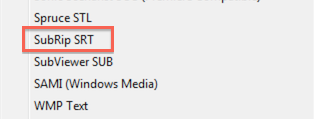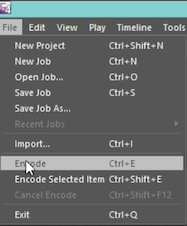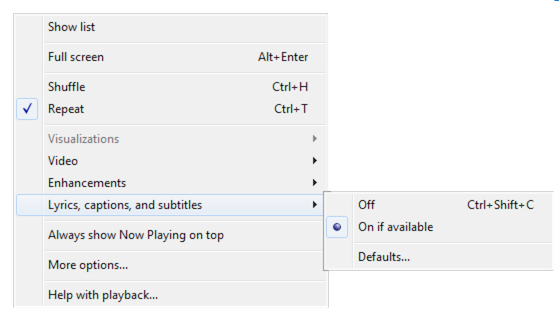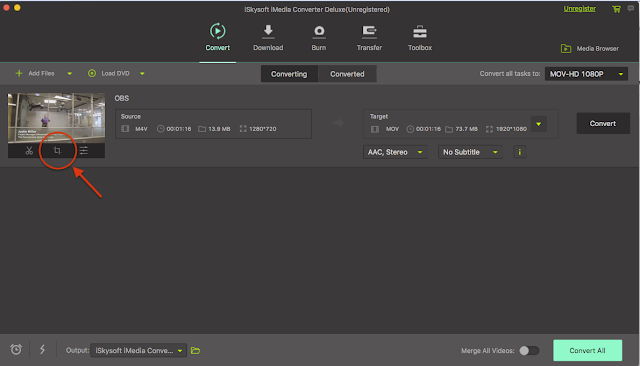Adding Captions to Windows Media Movies Using Microsoft Expresssion Encoder 4
There are three different ways of adding captions to Windows Media movies: SAMI captions, Windows Media Encoder 9 (using WMP Text captions), and Microsoft Expression Encoder 4 (using SRT captions).

Today we'll add them using Microsoft Expression Encoder 4. One of the problems with using SAMI captions for Windows Media is that the caption file must always be linked to the movie, since it's separate from the movie. A better way is to actually embed the captions into the movie so they travel with it and are always available as long as the user has closed captioning turned on in their Windows
Media Player.

We're going to start by creating our captions in MovieCaptioner as we normally would. Make sure you create an MPEG-4 or .MOV version of your WMV file for use in MovieCaptioner as it's QuickTime-based. You'll still use your WMV movie for the final version, however. Instead of breaking up the captions using a forced line break as you might usually do, we're not going to add any line breaks at all. In fact if your project already has line breaks, you're going to need to remove them. This is easily done by going to the Edit menu in MovieCaptioner and selecting Delete All Line Breaks "|" In Caption List.

The reason for this is because Expression Encoder will only read one line per caption. If you have 2 or more lines, it will only display the last line for each caption. Once you have all the captions set, just export as Subrip SRT.

Now that you have your SRT file, open Microsoft Expression Encoder 4. Select New Transcoding Project from the startup screen.

Once it opens, go to the File menu and import your WMV movie. After the movie loads go to the Metadata tab on the right, then scroll down if necessary and click the little cog wheel at the bottom of the Script Commands section of the Metadata tab. That will allow you to import your SRT file to the project.

Once the SRT file is imported, you should see all your captions listed in the Script Commands section. You can actually edit them here if necessary. Now you're ready to encode.

First, click on the Output tab (next to Metadata usually). Here you can set the file name and the target directory. After that's set go to the Encode tab and set it to whatever you need. I'm leaving the default in this instance.

Then go to the File menu and select Encode.

After it's done encoding you can open the encoded movie in Windows Media Player and you should see your captions appear right on cue.

If you don't see your captions, right-click on your movie and select Lyrics, captions, and subtitles and then select On if available from its submenu.

If they still don't display, there is a security setting you need to check. Right-click on your movie again and go to More options.... Click the Security tab and select the radio button next to Show local captions when present.

That should do it. Creating embedded captions for Windows Media movies is a snap with Microsoft Expression Encoder 4. And creating the caption file is also very easy if you use MovieCaptioner to do it. You can download a free 14-day, fully functional demo of MovieCaptioner and try it for yourself and see why so many are turning to this software for their captioning needs.


Today we'll add them using Microsoft Expression Encoder 4. One of the problems with using SAMI captions for Windows Media is that the caption file must always be linked to the movie, since it's separate from the movie. A better way is to actually embed the captions into the movie so they travel with it and are always available as long as the user has closed captioning turned on in their Windows
Media Player.

We're going to start by creating our captions in MovieCaptioner as we normally would. Make sure you create an MPEG-4 or .MOV version of your WMV file for use in MovieCaptioner as it's QuickTime-based. You'll still use your WMV movie for the final version, however. Instead of breaking up the captions using a forced line break as you might usually do, we're not going to add any line breaks at all. In fact if your project already has line breaks, you're going to need to remove them. This is easily done by going to the Edit menu in MovieCaptioner and selecting Delete All Line Breaks "|" In Caption List.

The reason for this is because Expression Encoder will only read one line per caption. If you have 2 or more lines, it will only display the last line for each caption. Once you have all the captions set, just export as Subrip SRT.

Now that you have your SRT file, open Microsoft Expression Encoder 4. Select New Transcoding Project from the startup screen.

Once it opens, go to the File menu and import your WMV movie. After the movie loads go to the Metadata tab on the right, then scroll down if necessary and click the little cog wheel at the bottom of the Script Commands section of the Metadata tab. That will allow you to import your SRT file to the project.

Once the SRT file is imported, you should see all your captions listed in the Script Commands section. You can actually edit them here if necessary. Now you're ready to encode.

First, click on the Output tab (next to Metadata usually). Here you can set the file name and the target directory. After that's set go to the Encode tab and set it to whatever you need. I'm leaving the default in this instance.

Then go to the File menu and select Encode.

After it's done encoding you can open the encoded movie in Windows Media Player and you should see your captions appear right on cue.

If you don't see your captions, right-click on your movie and select Lyrics, captions, and subtitles and then select On if available from its submenu.

If they still don't display, there is a security setting you need to check. Right-click on your movie again and go to More options.... Click the Security tab and select the radio button next to Show local captions when present.

That should do it. Creating embedded captions for Windows Media movies is a snap with Microsoft Expression Encoder 4. And creating the caption file is also very easy if you use MovieCaptioner to do it. You can download a free 14-day, fully functional demo of MovieCaptioner and try it for yourself and see why so many are turning to this software for their captioning needs.



Thanks very much for the informative how-to.
ReplyDeleteThis is definitely much better than any of the dozen tutorials I searched for today and has solved all of the problems I had. Thanks again.
Glad it was helpful, Chris. I know some of this info is pretty hard to dig up. Good luck with your projects!
ReplyDeleteGreetings from Ethiopia! Thank you very much for having the time to make our lives easier.
ReplyDeleteYou are very welcome Ahmed!
ReplyDeleteNice blog post.
ReplyDeleteDo you know how to have the captions placed on the video instead of under it? I thought maybe changing the script type in ExpressionEncoder to "subtitle" instead of "caption," but this option is not enabled.
I wonder if embedding the WMP.txt file (using Windows Media File Editor) in the header of the WMV file will put the subtitles on the video...?
I don't know Ken. Give it a try. I was just trying to import an SRT file into Expressions, but for some reason it's only letting me pick XML files. Not sure what's up with that. I'll have to mess around with it a bit more.
Delete